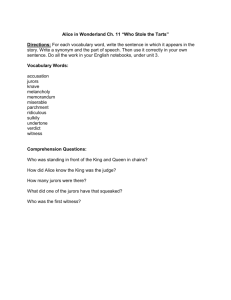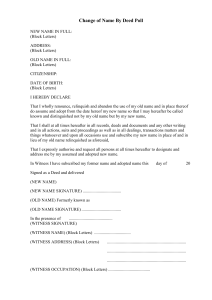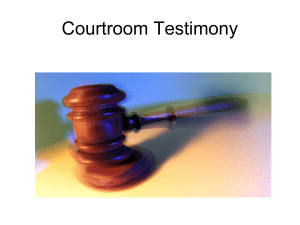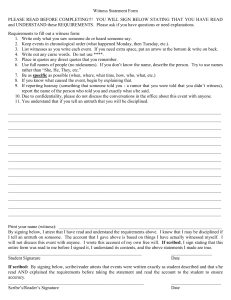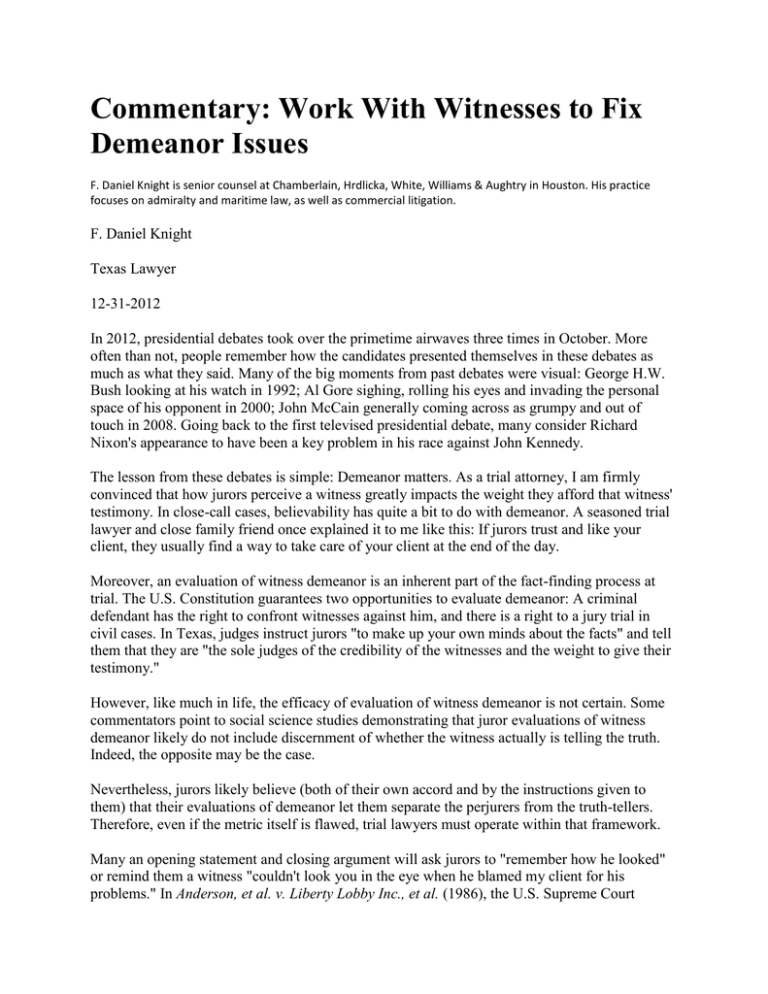
Commentary: Work With Witnesses to Fix
Demeanor Issues
F. Daniel Knight is senior counsel at Chamberlain, Hrdlicka, White, Williams & Aughtry in Houston. His practice
focuses on admiralty and maritime law, as well as commercial litigation.
F. Daniel Knight
Texas Lawyer
12-31-2012
In 2012, presidential debates took over the primetime airwaves three times in October. More
often than not, people remember how the candidates presented themselves in these debates as
much as what they said. Many of the big moments from past debates were visual: George H.W.
Bush looking at his watch in 1992; Al Gore sighing, rolling his eyes and invading the personal
space of his opponent in 2000; John McCain generally coming across as grumpy and out of
touch in 2008. Going back to the first televised presidential debate, many consider Richard
Nixon's appearance to have been a key problem in his race against John Kennedy.
The lesson from these debates is simple: Demeanor matters. As a trial attorney, I am firmly
convinced that how jurors perceive a witness greatly impacts the weight they afford that witness'
testimony. In close-call cases, believability has quite a bit to do with demeanor. A seasoned trial
lawyer and close family friend once explained it to me like this: If jurors trust and like your
client, they usually find a way to take care of your client at the end of the day.
Moreover, an evaluation of witness demeanor is an inherent part of the fact-finding process at
trial. The U.S. Constitution guarantees two opportunities to evaluate demeanor: A criminal
defendant has the right to confront witnesses against him, and there is a right to a jury trial in
civil cases. In Texas, judges instruct jurors "to make up your own minds about the facts" and tell
them that they are "the sole judges of the credibility of the witnesses and the weight to give their
testimony."
However, like much in life, the efficacy of evaluation of witness demeanor is not certain. Some
commentators point to social science studies demonstrating that juror evaluations of witness
demeanor likely do not include discernment of whether the witness actually is telling the truth.
Indeed, the opposite may be the case.
Nevertheless, jurors likely believe (both of their own accord and by the instructions given to
them) that their evaluations of demeanor let them separate the perjurers from the truth-tellers.
Therefore, even if the metric itself is flawed, trial lawyers must operate within that framework.
Many an opening statement and closing argument will ask jurors to "remember how he looked"
or remind them a witness "couldn't look you in the eye when he blamed my client for his
problems." In Anderson, et al. v. Liberty Lobby Inc., et al. (1986), the U.S. Supreme Court
upheld a bench trial verdict based, in part, upon observations of demeanor. In that case, the trial
judge observed that a critical witness fidgeted when answering key questions, shifted his eyes
from the floor to the ceiling and manifested "all other indicia traditionally attributed to
perjurers."
From interviewing jurors after trials, I find the Anderson criteria to be a common metric by
which jurors believe they can root out perjury, as well as volume, tone and pace of a witness'
verbal response.
I do not advocate that counsel instruct witnesses to put on a show or to behave differently than
they normally would. Witnesses are not actors; they are real people who would appear
disingenuous if they assumed character traits or behaviors inconsistent with their normal
personae. However, any testimony-preparation session must devote time to explaining the
concept of demeanor, as well evaluating and correcting the witness' demeanor through a series of
exercises.
In preparation, it helps to show witnesses clips of good and bad depositions. If possible, I will
show the witness his prior videotaped testimony from other matters and point out things he
previously has done, both helpful (smiling, good posture, moderate volume and even tone when
answering a tough question) and not helpful (eye rolling, lack of eye contact or shifting around
during tough questions).
If prior depositions are not available, I will show the witness deposition clips from YouTube and
other websites. In particular, I find very instructive the Bill Gates testimony from the Microsoft
antitrust litigation. Plus, it is always advantageous to tell a witness that he can perform better in a
deposition than one of the richest people on earth.
I also try to identify demeanor difficulties with witnesses by subjecting them to crossexamination in testimony preparation. Making the practice cross-examination as close to real as
possible and pushing the witness both enable the lawyer to observe how the witness handles
adversity. Seeing a witness' physical response and hearing the verbal response lets a lawyer make
an informed decision about how to move forward.
After identifying the issues, the attorney must work with the witness to manage and correct his
demeanor, to the extent possible. For example, if a witness begins to talk rapidly when faced
with a tough question, a quick fix can be as simple as telling the witness to take a short pause and
breathe to steady himself before he begins to answer. Jurors likely won't notice this, but pausing
and breathing will calm the witness, slow the rate of his speech and help him avoid word
stumbles.
The major difference between the presidential debates and testifying in court is that the
candidates get multiple opportunities to make an impression, while the witness usually gets only
one. Understanding the role of demeanor can make the difference in a close case, much in the
same way it arguably has made the difference in past close elections.
Reprinted with permission from the December 31, 2012 edition of Texas Lawyer. © 2012 ALM
Media Properties, LLC. All rights reserved. Further duplication without permission is prohibited.

